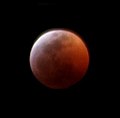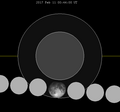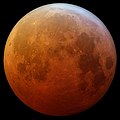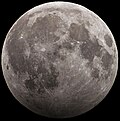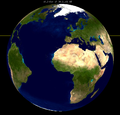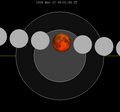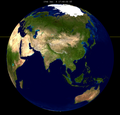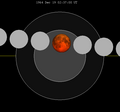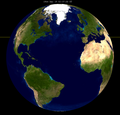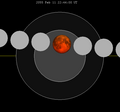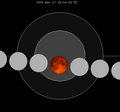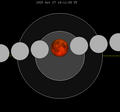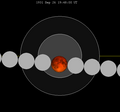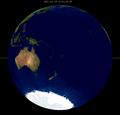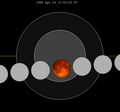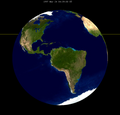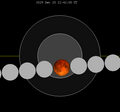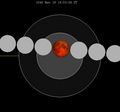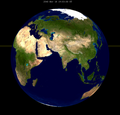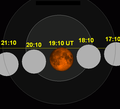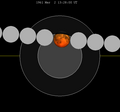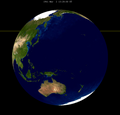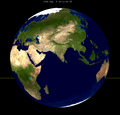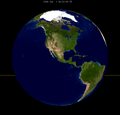January 2019 lunar eclipse
A total lunar eclipse occurred at the Moon’s ascending node of orbit on Monday, January 21, 2019,[1] with an umbral magnitude of 1.1966. A lunar eclipse occurs when the Moon moves into the Earth's shadow, causing the Moon to be darkened. A total lunar eclipse occurs when the Moon's near side entirely passes into the Earth's umbral shadow. Unlike a solar eclipse, which can only be viewed from a relatively small area of the world, a lunar eclipse may be viewed from anywhere on the night side of Earth. A total lunar eclipse can last up to nearly two hours, while a total solar eclipse lasts only a few minutes at any given place, because the Moon's shadow is smaller. Occurring about 10 hours before perigee (on January 21, 2019, at 15:00 UTC), the Moon's apparent diameter was larger.[2] Because the Moon was near its perigee on January 21, it can be described as a "supermoon".[3] As this supermoon was also a wolf moon (the first full moon in a calendar year), it was referred to as a "super blood wolf moon"; blood refers to the typical red color of the Moon during a total lunar eclipse.[4] This was the last total lunar eclipse until May 2021. This was a Super Full Moon because occurred less than a day before perigee and the Moon was less than exactly 360,000 km (223,694 mi). The Griffith Observatory in Los Angeles, California captured video showing a meteoroid between the size of an acorn and tennis ball impacting the Moon during the eclipse.[5] The impact was observed during totality, at 4:41 UTC, on the left side of the Moon.[6] It is the only documented case of a lunar impact during a total lunar eclipse.[7][8] AppearanceThis lunar eclipse took place in the constellation of Cancer, just west of the Beehive Cluster. VisibilityThe eclipse was completely visible over North and South America and western Europe, seen rising over the central Pacific Ocean, and setting over Africa, most of Europe, and the Middle East.[9]
TimingContact points relative to Earth's umbral and penumbral shadows, here with the Moon near its descending node (left), and the hourly motion for the January 2019 lunar eclipse (right)
The penumbral phases of the eclipse changes the appearance of the Moon only slightly and is generally not noticeable.[11]
GalleryAmerica
Europe
Impact sightedLivestreams detected a flash of light while viewing the eclipse. It was "likely caused by the crash of a tiny, fast-moving meteoroid left behind by a comet."[7] Originally thinking it was electronic noise from the camera, astronomers and citizen scientists shared the visual phenomenon with each other to identify it.[7] When totality was just beginning at 4:41 UT, the tiny speck of light blinked south of a nearly 55-mile-wide crater in the western part of the moon.[12] The location of the impact may be somewhere in the lunar highlands, south of Byrgius crater, according to Justin Cowart, a graduate student in geosciences at Stony Brook University in New York who first saw the flash of light.[7] “A meteoroid about this size hits the moon about once a week or so,” said Cowart.[12] This may be the first time that a collision, during a total lunar eclipse, was captured on video.[7] “I have not heard of anyone seeing an impact like this during a lunar eclipse before,” said Sara Russell, a professor of planetary sciences at the Natural History Museum in London.[7] People posted their images and video of a flicker of light as news spread quickly on social media.[12] Working overtime, co-director of the Moon Impacts Detection and Analysis System, MIDAS, an astrophysicist at the University of Huelva in Spain, Jose Maria Madiedo, set up eight telescopes to watch for any impacts during the eclipse.[12] “Something inside of me told me that this time would be the time,” said Madiedo.[12] A paper calculated a mass between 20 and 100 kilograms and diameter of 30 to 50 cm that may have caused a 7–15 meter crater located "inside a triangle with vertices in the Lagrange H, K and X craters".[13] Other astronomers estimated a 10-15 meter crater from a 45 kg asteroid moving 61,000 km/h.[14] Eclipse detailsShown below is a table displaying details about this particular lunar eclipse. It describes various parameters pertaining to this eclipse.[15]
Eclipse seasonThis eclipse is part of an eclipse season, a period, roughly every six months, when eclipses occur. Only two (or occasionally three) eclipse seasons occur each year, and each season lasts about 35 days and repeats just short of six months (173 days) later; thus two full eclipse seasons always occur each year. Either two or three eclipses happen each eclipse season. In the sequence below, each eclipse is separated by a fortnight.
Related eclipsesEclipses in 2019
Metonic
Tzolkinex
Half-Saros
Tritos
Lunar Saros 134
Inex
Triad
Lunar eclipses of 2016–2020This eclipse is a member of a semester series. An eclipse in a semester series of lunar eclipses repeats approximately every 177 days and 4 hours (a semester) at alternating nodes of the Moon's orbit.[16] The penumbral lunar eclipses on March 23, 2016 and September 16, 2016 occur in the previous lunar year eclipse set, and the penumbral lunar eclipses on June 5, 2020 and November 30, 2020 occur in the next lunar year eclipse set.
Saros 134This eclipse is a part of Saros series 134, repeating every 18 years, 11 days, and containing 72 events. The series started with a penumbral lunar eclipse on April 1, 1550. It contains partial eclipses from July 7, 1694 through October 13, 1856; total eclipses from October 25, 1874 through July 26, 2325; and a second set of partial eclipses from August 7, 2343 through November 12, 2505. The series ends at member 72 as a penumbral eclipse on May 28, 2830. The longest duration of totality will be produced by member 38 at 100 minutes, 23 seconds on May 22, 2217. All eclipses in this series occur at the Moon’s ascending node of orbit.[17]
Eclipses are tabulated in three columns; every third eclipse in the same column is one exeligmos apart, so they all cast shadows over approximately the same parts of the Earth.
Tritos seriesThis eclipse is a part of a tritos cycle, repeating at alternating nodes every 135 synodic months (≈ 3986.63 days, or 11 years minus 1 month). Their appearance and longitude are irregular due to a lack of synchronization with the anomalistic month (period of perigee), but groupings of 3 tritos cycles (≈ 33 years minus 3 months) come close (≈ 434.044 anomalistic months), so eclipses are similar in these groupings.
Inex seriesThis eclipse is a part of the long period inex cycle, repeating at alternating nodes, every 358 synodic months (≈ 10,571.95 days, or 29 years minus 20 days). Their appearance and longitude are irregular due to a lack of synchronization with the anomalistic month (period of perigee). However, groupings of 3 inex cycles (≈ 87 years minus 2 months) comes close (≈ 1,151.02 anomalistic months), so eclipses are similar in these groupings.
Half-Saros cycleA lunar eclipse will be preceded and followed by solar eclipses by 9 years and 5.5 days (a half saros).[19] This lunar eclipse is related to two annular solar eclipses of Solar Saros 141.
See alsoReferences
External links |
|||||||||||||||||||||||||||||||||||||||||||||||||||||||||||||||||||||||||||||||||||||||||||||||||||||||||||||||||||||||||||||||||||||||||||||||||||||||||||||||||||||||||||||||||||||||||||||||||||||||||||||||||||||||||||||||||||||||||||||||||||||||||||||||||||||||||||||||||||||||||||||||||||||||||||||||||||||||||||||||||||||||||||||||||||||||||||||||||||||||||||||||||||||||||||||||||||||||||||||||||||||||||||||||||||||||||||||||||||||||||||||||||||||||||||||||||||||||||||||||||||||||||||||||||||||||||||||||||||||||||||||||||||||||||||||||||||||||||||||||||||||||||||||||||||||||||||||||||||||||||||||||||||||||||||||||||||||||||||||||||||||||||||||||||||||||||||||||||||
Portal di Ensiklopedia Dunia













